
Armillaria is a genus of fungi that includes the A. mellea species known as honey fungi that live on trees and woody shrubs. It includes about 10 species formerly categorized summarily as A. mellea. Armillarias are long-lived and form the largest living fungi in the world. The largest known organism covers more than 3.4 square miles (8.8 km2) in Oregon's Malheur National Forest and is estimated to be 2,500 years old. Some species of Armillaria display bioluminescence, resulting in foxfire.
Galls or cecidia are a kind of swelling growth on the external tissues of plants. Plant galls are abnormal outgrowths of plant tissues, similar to benign tumors or warts in animals. They can be caused by various parasites, from viruses, fungi and bacteria, to other plants, insects and mites. Plant galls are often highly organized structures so that the cause of the gall can often be determined without the actual agent being identified. This applies particularly to insect and mite plant galls. The study of plant galls is known as cecidology.

The Ancient and Mystical Order Rosæ Crucis (AMORC), also known as the Rosicrucian Order, is the largest Rosicrucian organization in the world. It has various lodges, chapters and other affiliated bodies throughout the globe, operating in 19 different languages. It operates as a fraternal order in the mystical Western Esoteric Tradition

The carrot fly is a pest of gardens and farms, and mainly affects the crop of carrots, but can also attack parsnips, parsley and celery. It is a member of the family Psilidae.
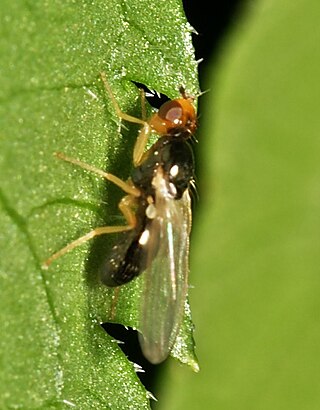
The Psilidae are family of flies. Commonly called the rust flies, at least 38 species are in four genera. The carrot fly is a member of this group. They are found mainly in the Holarctic.

Rubus pensilvanicus, known commonly as Pennsylvania blackberry, is a prickly bramble native to eastern and central North America from Newfoundland south to Georgia, west as far as Ontario, Minnesota, Nebraska, and Arkansas. The species is also established as a naturalized plant in California.
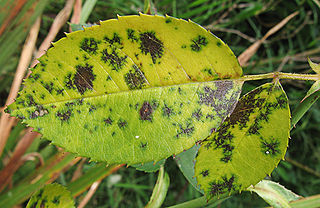
Diplocarpon rosae is a fungus that creates the rose black spot disease. Because it was observed by people of various countries around the same time, the nomenclature for the fungus varied with about 25 different names. The asexual stage is now known to be Marssonina rosae, while the sexual and most common stage is known as Diplocarpon rosae.

Helotiales is an order of the class Leotiomycetes within the division Ascomycota. The taxonomy within Helotiales has been debated. It has expanded significantly as genomic techniques for taxonomical identification have become more commonly used. As of February 2020, the order is estimated to contain 30 accepted families, 519 genera, and 6266 species.
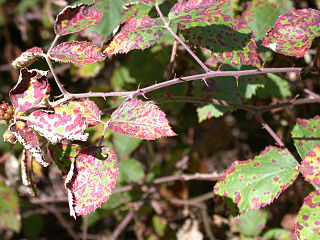
Phragmidium violaceum is a plant pathogen native to Europe, Africa, and the Middle East. It primarily infects Rubus species.

Phragmidium mucronatum is a plant pathogen that causes rose rust.

Diplolepis rosae is a gall wasp which causes a gall known as the rose bedeguar gall, bedeguar gall wasp, Robin's pincushion, mossy rose gall, or simply moss gall. The gall develops as a chemically induced distortion of an unopened leaf axillary or terminal bud, mostly on field rose or dog rose shrubs. The female wasp lays up to 60 eggs within each leaf bud using her ovipositor. The grubs develop within the gall, and the wasps emerge in spring; the wasp is parthenogenetic with fewer than one percent being males.

An aecium is a specialised reproductive structure found in some plant pathogenic rust fungi that produce aeciospores. Aecia may also be referred to as "cluster cups". The term aecidium is used interchangeably but is not preferred.

Phragmidium is a genus of rust fungus that typically infects plant species in the family Rosaceae. It is characterised by having stalked teliospores borne on telia each having a row of four or more cells. All species have a caeoma which is a diffuse aecidium lacking a peridium.
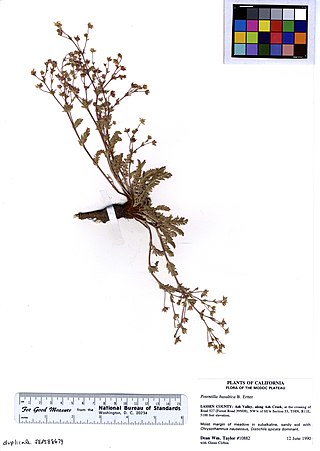
Potentilla basaltica is a species of flowering plant in the rose family known by the common names Soldier Meadows cinquefoil and basalt cinquefoil. It is endemic to a small area of the Modoc Plateau and Warner Mountains in northeastern California and northwestern Nevada.
Tylopilus sanctae-rosae is a bolete fungus in the family Boletaceae. Found in Costa Rica, where it grows under the oak species Quercus oleoides, it was described as new to science in 1983 by mycologist Rolf Singer.
Piricaudiopsis rosae is a fungus occurring on dead branches of Rosa chinensis, hence its name. It was first found in a tropical forest in southern China. It differs from other Piricaudiopsis species in conidial morphology and in the proliferation of its conidiogenous cell. The presence or proliferation of the conidiogenous cells and the conidial appendages, as well as the height of its conidia are considered putative phylogenetic characters of this genus.

Vincent W. Cochrane was an American mycologist, whose research focused on the biochemistry and physiology of fungi. He is particularly known for his 1958 textbook, The Physiology of the Fungi.
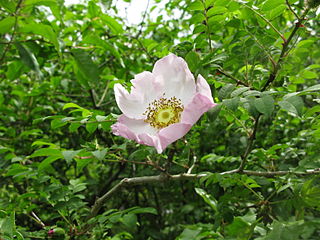
Rosa hirtula, the sanshou-bara or Hakone rose, is a species of flowering plant in the family Rosaceae. It is found only in the vicinity of Mount Fuji and neighboring Mount Hakone in Japan, and is the town flower of Hakone.















